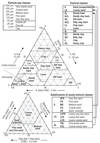Physical properties
Soil structure
The clumping of the soil textural components of sand, silt and clay forms aggregates and the further association of those aggregates into larger units forms soil structures called peds. The soil structure affects aeration, water movement, conduction of heat, plant root growth and resistance to erosion. Water has the strongest effect on soil structure due to its solution and precipitation of minerals and its effect on plant growth.
Soil depth
The original definition of the solum was the topsoil (‘A’ horizons) + subsoil (‘E’ and ‘B’) horizons; where the ‘C’ horizons were defined as strata with little evidence of pedogenesis. The “effective” soil depth then was considered the solum thickness. However, roots and biological activity occurs often in the C horizon and soil depth should hence include this layer. In practice soil surveys use arbitrary depth limits (eg 200 cm) to study soils.
Soil water characteristics
Available soil water
When a field is flooded, the air space is displaced by water. The field will drain under the force of gravity until it reaches what is calledfield capacity (FC), at which point the smallest pores are filled with water and the largest with water and air. Field capacity corresponds with a suction equivalent of 1/3 bar. Plants that use the water must produce increasingly higher suction, finally up to 15 bar. At 15 bar suction, the soil water amount is called wilting point (WP). At that suction the plant cannot sustain its water needs as water is still being lost from the plant by transpiration; the plant's turgidity is lost, and it wilts. The amount of water remaining in a soil drained to field capacity and the amount that is available are functions of mainly soil texture. The available soil moisture can be determined in the laboratory as shown in the soil moisture retention curves.
Soil texture
The mineral components of soil, sand, silt and clay, determine a soil's texture. Soil texture affects soil behavior, in particular its retention capacity for nutrients and water.
Soil components larger than 2.0 mm are considered as rock and gravel and can be included in textural class.For example, a sandy loam soil with 20% gravel would be called a gravelly sandy loam. When the organic component of a soil is substantial, the soil is called organic soil rather than mineral soil.
Color
In general, soil color is determined by organic matter content, drainage conditions, and the degree of oxidation. Soil color, while easily discerned, has little use in predicting soil characteristics It is of use in distinguishing boundaries within a soil profile, determining the origin of a soil's parent material, as an indication of wetness and waterlogged conditions, and as a qualitative means of measuring organic, salt and carbonate contents of soils.
Consistency
Consistency is the ability of soil to stick together and resist fragmentation. It is of use in predicting cultivation problems and the engineering of foundations. Consistency is measured at three moisture conditions: air-dry, moist and wet. More precise measures of soil strength are required prior to construction.
Porosity
Pore space is that part of the bulk volume that is not occupied by either mineral or organic matter but is open space occupied by either air or water. Ideally, the total pore space should be 50% of the soil volume. The air space is needed to supply oxygen to organisms decomposing organic matter, humus, and plant roots. Pore space also allows the movement and storage of water and dissolved nutrients.
Density
Density is the weight per unit volume of an object. Particle density is the density of the mineral particles that make up a soil; i.e., it excludes pore space and organic material. Particle density averages approximately 2.65 g/cc. e. A high bulk density indicates either compaction of the soil or high sand content. A lower bulk density by itself does not necessarily indicate higher suitability for plant growth.
Water flows
Water moves through soil due to the force of gravity, osmosis and capillarity. At zero to one-third bar suction, water moves through soil due to gravity; this is called saturated flow. At higher suctions, water movement is called unsaturated flow. Water flows can be measured in the field (Hydraulic conductivity). Important information on water flows in the soil can be obtained from its field description of the drainage class and associated features (gleyic and stagnic properties).





